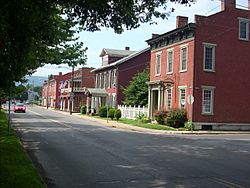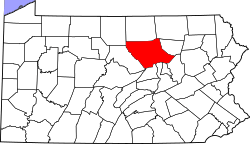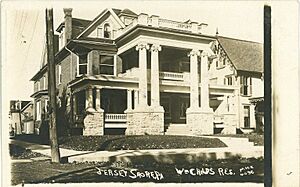Jersey Shore, Pennsylvania facts for kids
Quick facts for kids
Jersey Shore, Pennsylvania
Waynesburg
|
|
|---|---|
|
Borough
|
|

A view of Jersey Shore
|
|

Location of Jersey Shore in Lycoming County, Pennsylvania.
|
|

Map of Pennsylvania highlighting Lycoming County
|
|
| Country | United States |
| State | Pennsylvania |
| County | Lycoming |
| Settled | 1800 |
| Incorporated | 1826 |
| Government | |
| • Type | Borough Council |
| Area | |
| • Total | 1.18 sq mi (3.06 km2) |
| • Land | 1.16 sq mi (3.00 km2) |
| • Water | 0.02 sq mi (0.06 km2) |
| Elevation | 604 ft (184 m) |
| Population
(2020)
|
|
| • Total | 4,166 |
| • Density | 3,597.58/sq mi (1,389.30/km2) |
| Time zone | UTC-5 (Eastern (EST)) |
| • Summer (DST) | UTC-4 (EDT) |
| ZIP codes |
17740
|
| Area code(s) | 570 and 272 |
| FIPS code | 42-38128 |
| GNIS feature ID | 1213696 |
Jersey Shore is a small town, called a borough, located in Lycoming County, Pennsylvania, in the United States. It sits along the West Branch Susquehanna River, about 15 miles (24 km) west of Williamsport. It's part of the Williamsport area. In the past, Jersey Shore was known for its farms, railroad shops, cigar factories, and a large silk mill. In 2020, about 4,158 people lived there.
Contents
History of Jersey Shore
Jersey Shore officially became a borough on March 15, 1826. But its story began about 50 years earlier. The first settlers arrived around 1772 on the other side of the West Branch Susquehanna River.
Early Settlers and Fort Antes
One of the first settlers was Colonel John Henry Antes. He built a farm and a gristmill (a mill for grinding grain) near Antes Creek. His strong home, called Fort Antes, was a safe place for early settlers. They used it to protect themselves from attacks during the American Revolution.
Some settlers who had taken shelter at Fort Antes were among the first to be killed when the fort was attacked. This happened just before an event called the Big Runaway. Many pioneers living on the north side of the river were known as the Fair Play Men. This group of squatters lived outside the usual government rules of Pennsylvania at the time. Many settlers didn't return to the area until after Sullivan's Expedition. This expedition pushed the Lenape and other Native American groups allied with the British further west.
How Jersey Shore Got Its Name
Jersey Shore was first named Waynesburg around 1785 by two brothers, Reuben and Jeremiah Manning. They were the ones who planned out the town.
At the same time, another settlement grew on the eastern side of the West Branch Susquehanna River. A friendly competition started between the two settlements. People on the eastern side began calling the town on the western side "Jersey Shore." This was because the Manning family had moved there from New Jersey. The nickname stuck so well that in 1826, the original name of Waynesburg was officially changed to Jersey Shore.
Important People and Businesses
Jersey Shore's location on the river, near where Pine Creek flows into it, made it a great spot for traders. They would supply pioneers heading further west.
Thomas Martin was a farmer known for his fair prices. He sold his produce (like potatoes) to locals and travelers. He always sold his goods for what he thought they were worth, no more, no less. This made him a respected leader in Jersey Shore. His son, Lewis Martin, also became well-known for his honesty. Lewis served as a county prothonotary (a court official) and a deputy U.S. Marshal (a law enforcement officer).
The Reverend John Hays Grier arrived in Jersey Shore in 1814. He was a Presbyterian missionary who planned to serve pioneers in the west. But he stopped in Jersey Shore one Sunday and ended up staying. He built a strong church community there. He also served a church in Lock Haven for 14 years. Later, he focused only on the Jersey Shore church for another 23 years. Rev. Grier was also elected sheriff of Lycoming County in 1822.
Railroad Boom and Industry Growth
Jersey Shore was once very important in the railroad industry. In 1901, the New York Central Railroad decided to build large rail car shops nearby in Avis. To attract workers and businesses to Jersey Shore, people built the Jersey Shore Electric Street Railway. This was a trolley line that connected the town to the new railroad shops.
In 1905, another trolley line, the Jersey Shore and Antes Fort Railway, started running. It connected the town to the Pennsylvania Railroad station. These two trolley lines changed Jersey Shore from a small stop on the West Branch Canal to a busy industrial town. More than 1,000 skilled mechanics worked at the car shops, earning good wages. Other early businesses included the American Balance Valve and Machine Works, the Susquehanna Silk Mill, and the Jersey Shore Creamery Company.
Jersey Shore Hospital
On October 10, 1911, four doctors started Jersey Shore Hospital. It began with 14 beds in a rebuilt home. Over the years, it added X-ray services, a maternity ward, and a place for nurses to live. In 1922, the hospital became a community hospital and a not-for-profit organization, which it still is today.
Jersey Shore Steel Company
The Jersey Shore Steel Company was started in 1938 by John A. Schultz, near the end of the Great Depression. The company made steel rails for railroads. In its first year, it produced 15,000 tons of steel.
After John A. Schultz passed away in 1943, his sons Charles and John A. Jr. took over. They saw the company grow, but also face challenges. A huge fire almost destroyed the steel mill in 1963. Then, the Agnes Flood in 1972 caused a lot of damage. Today, the company is still owned by the Schultz family. It has two mills and can produce 170,000 tons of rail steel each year.
Historic District
The Jersey Shore Historic District was added to the National Register of Historic Places in 1975. This means it's recognized as an important historical area.
Industry and Jobs
In the past, Jersey Shore had many different types of jobs. There were farms, railroad shops, and factories that made cigars. There was also a foundry (where metal is cast) and a large silk mill.
Woolrich, Inc., a well-known clothing company, used to have a mill in Jersey Shore. This mill, along with others in nearby towns, closed in 2008.
Geography and Location
Jersey Shore is located at 41°12′9″N 77°16′0″W / 41.20250°N 77.26667°W. It is just east of where Pine Creek meets the Susquehanna River. The town is surrounded by Porter Township to the north, west, and south. To the east, across the Susquehanna River, is Nippenose Township.
If a crow could fly straight, Jersey Shore is about 130 miles (209 km) northwest of Philadelphia and 165 miles (266 km) east-northeast of Pittsburgh.
The United States Census Bureau says the borough has a total area of about 1.2 square miles (3.1 km2), and all of it is land.
Population Information
| Historical population | |||
|---|---|---|---|
| Census | Pop. | %± | |
| 1840 | 525 | — | |
| 1850 | 640 | 21.9% | |
| 1860 | 1,365 | 113.3% | |
| 1870 | 1,394 | 2.1% | |
| 1880 | 1,411 | 1.2% | |
| 1890 | 1,853 | 31.3% | |
| 1900 | 3,070 | 65.7% | |
| 1910 | 5,381 | 75.3% | |
| 1920 | 6,103 | 13.4% | |
| 1930 | 5,781 | −5.3% | |
| 1940 | 5,432 | −6.0% | |
| 1950 | 5,595 | 3.0% | |
| 1960 | 5,613 | 0.3% | |
| 1970 | 5,322 | −5.2% | |
| 1980 | 4,631 | −13.0% | |
| 1990 | 4,353 | −6.0% | |
| 2000 | 4,482 | 3.0% | |
| 2010 | 4,361 | −2.7% | |
| 2020 | 4,158 | −4.7% | |
| 2021 (est.) | 4,132 | −5.3% | |
| Sources: | |||
According to the census from 2000, there were 4,482 people living in Jersey Shore. These people lived in 1,771 households, with 1,190 of them being families. The population density was about 3,655 people per square mile (1,411 people per km2).
Most of the people living in Jersey Shore were White (98.75%). A small number were African American, Native American, Asian, or from other backgrounds.
About 34.6% of households had children under 18 living with them. The average household had 2.45 people, and the average family had 2.98 people.
The population was spread out by age:
- 26.0% were under 18 years old.
- 8.9% were between 18 and 24.
- 29.4% were between 25 and 44.
- 18.7% were between 45 and 64.
- 17.1% were 65 years or older.
The average age in Jersey Shore was 36 years.
Fun Places to Visit
Jersey Shore is the starting point for the 65-mile (105 km) long Pine Creek Rail Trail. This is a popular path for biking and walking.
Local Media
- WEJS (Radio station)
- WJSA-FM (Radio station)
- WXPI (Radio station)
Famous People from Jersey Shore
- Robbie Gould: A professional football player.
- Hunter S. Thompson: A well-known author and journalist.
See also
 In Spanish: Jersey Shore (Pensilvania) para niños
In Spanish: Jersey Shore (Pensilvania) para niños



